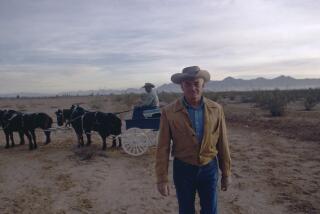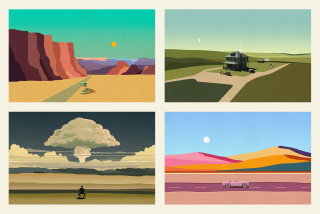Even Cowgirls Get to Shoot : . . . AND ONE GETS TO CRACK THE WHIP IN A TWO-PART MOVIE
SANTA FE, N.M. — The two lead characters are women. So are the executive producer, the two producers and the scriptwriter.
With all that female presence, is “Buffalo Girls” a women’s Western?
“I think people will run for the exits if you say that,” cautions executive producer Suzanne de Passe, somewhat surprised at the question.
“I would like to think that it’s a Western, it’s a great story and, yes, there are female characters but we’re trying not to put chintz curtains up all over it.”
There’s a scene, for instance, that unfolds at Buffalo Bill’s Wild West Show in London. Calamity Jane (Anjelica Huston) and Sitting Bull (Russell Means) are having a tense confrontation.
Calamity, angered by the Sioux chief’s humiliation of her old Indian companion No Ears, is holding a knife to Sitting Bull’s chest.
“You mess with No Ears,” she growls, “I’ll eat your liver.”
So much for chintz curtains.
The four-hour movie, which airs Sunday and Monday on CBS, is based on Larry McMurtry’s 1990 novel. It’s an epic tale about the disappearance of the Wild West and some of the real-life characters--plus a few fictitious ones--who were around at the time.
The central figure is Calamity Jane, the cigar-smoking, whip-cracking mule skinner who shows a strong feminine side in addition to her masculine manners. Dora Du Fran (Melanie Griffith) is a frontier whorehouse madam and Calamity’s best friend. Their friendship is at the heart of the story.
“Since the two lead characters are women, one hopes that it will appeal to women and that it will have a woman’s sensibility,” Huston says in a phone interview.
“But in Calamity’s case, and in Dora’s too,” she adds, “they are living in a man’s world in which they have to be strong to survive. It was cold, it was hard--I mean, just being on a movie set--but to have actually lived in that situation for women must have been wildly uncomfortable.”
As the story begins, Calamity’s daughter by Wild Bill Hickok (Sam Elliott) has been given up for adoption to a wealthy English couple. Calamity eventually has regrets and, cajoled by Buffalo Bill (Peter Coyote), travels to England with the Wild West Show in hopes of getting the child back.
She is joined by three loyal sidekicks: a couple of grizzled beaver trappers named Bartle Bone (Jack Palance) and Jim Ragg (Tracey Walter) and a mystical old Indian, No Ears (Floyd Red Crow Westerman). Along for the ride is Annie Oakley, played by Reba McEntire.
Meanwhile, back at the ranch, Dora maintains a hopeless love affair with a cowpoke named T. Blue (Gabriel Byrne). But Blue and Dora can’t quite get it together and Dora ultimately falls into a marriage of convenience with a handsome young ranch hand. The marriage produces a baby, which becomes the denouement of the story with Calamity on hand to lend support and comfort.
Most of “Buffalo Girls” is shot during winter in New Mexico, the outdoor locations near Santa Fe.
It’s mid-December and a frigid wind is whipping through the set of an old Western town. The actors are in light clothing because it’s supposed to be spring, not winter. The unpaved streets have been soaked down to capture the raw feeling of life on the frontier.
Griffith’s Dora Du Fran, trying to cross a street to the hotel where her business is located, is stuck in gooey ankle-deep mud. A young man (Liev Schreiber) driving a horse-drawn buckboard brakes to a stop, leaps off, swoops Dora out of the muck and gallantly carries her up the hotel steps.
Director Rod Hardy shoots a number of takes to get what he needs, taking up most of the day’s schedule.
Despite the rigors of shooting in a New Mexican winter, Griffith is cheerful and upbeat. She’s been able to spend weekends at home in Aspen, Colo. During the week she stays at her father’s ranch in Pecos, and husband Don Johnson is coming to visit the next day.
“It’s been great,” she tells a visitor between takes. “You know, I’ve never done a Western before. Well, a long time ago I did one, but I don’t remember what it was.”
And what about the hardships?
“The only physical difficulty is that I have to wear a corset every day,” she says, “and it changes your waistline by about four inches.”
The hardships were more trying for other cast and crew members. During filming around Santa Fe the temperature often dropped well below freezing.
“We couldn’t have picked a worse time of year to shoot this picture,” says Australian director Hardy. “On our first day we had everything from mud, rain, hail, snow--and we were shooting at about 9,000 feet above Los Alamos. People were getting very tired at that altitude, and it got very, very cold.”
To re-create a Wild West Show performance in London, the company moved to an indoor coliseum in Albuquerque.
Lunching in the warmth of his trailer, Coyote remembers how it was farther north:
“Yeah, being on horseback at 6 in the morning in 7-degree weather. It was so cold up in Santa Fe, when I got down off my horse I couldn’t feel my feet. The wind would blow through and hit you every day--it was awful.”
Huston concurs: “We all had bouts of pneumonia or influenza and minor aches and pains, so it was tough but that’s part of what Westerns are about, I guess.”
Floyd Red Crow Westerman had even worse problems. In August he contracted pneumonia and had barely recovered by the time shooting started in November.
“When you have pneumonia your lungs are at a weak point,” he says, “and we were shooting at 9,400 feet. I needed oxygen between every one of my scenes and a medic was with me pretty constantly.”
Palance, chafing at a delay in shooting a scene in Albuquerque, sounds disenchanted with the Land of Enchantment.
“I’ve come here many times because I like it, I love it really,” he says, “but the altitude and the dryness--for some of us with bad noses, like mine, it’s a problem.”
The New Mexico climate offers a taste of the harsh conditions the pioneers of the West had to endure. But the theme of this sprawling story is change, not climate.
“This was really the last moment the West was wild,” Huston notes. “After Buffalo Bill killed off all the buffalo and really made it into a circus, that was that.”
In one scene, the Wild West Show performers make a spectacular grand entrance with Buffalo Bill straddling two horses at full gallop. The audience includes an appreciative Queen Victoria, who actually attended the first London performance.
“It’s not history,” says Coyote, offering his tack on the story and the role he plays. “Buffalo Bill was a really heroic man, but in Larry McMurtry’s reworking of the mythology he stands for the guy who was merchandising the West.
“What McMurtry was getting at is that moment at which the Old West passed into legend and Buffalo Bill was one of the purveyors of the legend. In other words, after he had done this extraordinary life, he was trying to cash in on it.”
He cashed in with the Wild West Show, which toured the United States, Canada and Europe with astonishing success.
After wrapping in New Mexico, the company moved to England for the final 10 days of production, even though the London show scenes had already been shot in Albuquerque.
Returning home to Los Angeles, Huston recalls how she prepared to play Calamity Jane.
“I read a lot, I bought everything there was to buy on the subject,” she says. “Actually, the information on Calamity Jane is rather minimal. She was sort of buried in the annals of history.
A voice coach helped her “find an accent,” and she took whipping lessons because Calamity was essentially a bull-whipper and mule skinner.
“She was also a scout for General Custer but she came to him as a mule whacker,” says Huston, slipping easily into the vernacular of the time.
Buffalo Bill would have been proud.
“Buffalo Girls” airs Sunday and Monday at 9 p.m. on CBS.
More to Read
Only good movies
Get the Indie Focus newsletter, Mark Olsen's weekly guide to the world of cinema.
You may occasionally receive promotional content from the Los Angeles Times.










